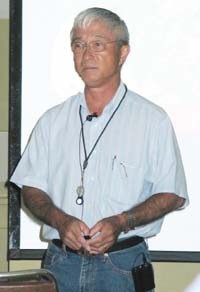Brazilian Soybean Expert Discusses Rust
Brazilian Soybean Expert Discusses Rust

More than 250 people crowded into the conference facility at the University of Kentucky Research and Education Center on a Saturday morning to hear from one of the world’s leading soybean rust experts from Brazil.
Asian Soybean Rust arrived in the United States last fall, and intensive monitoring and educational programs have been under way since to help growers watch for the disease and understand how to cope with it. Rust is a devastating disease that can defoliate a plant quickly reducing yields up to 100 percent.
Brazilian growers began dealing with rust in 2001 and have seen billions in losses as a result of the disease. Nearly all the Brazilian soybean acres are impacted by rust to some extent. Jose Tadashi Yorinori, with EMPRAPA Soya, Londrina, Brazil, has been a leader in the fight to combat it within that country and has studied the disease extensively around the world.
Yorinori was in Kentucky as part of a multistate trip to look at soybean rust in the United States. His visit to west Kentucky was sponsored by the Kentucky Soybean Promotion Board.
So far this year, rust has been found in some southern states but has not been found in Kentucky. There are 47 sentinel plots in the state being checked regularly to monitor for the disease, and a number of spore traps are also set up.
Yorinori said there has been a great deal of information exchanged between the United States and Brazil for many years on soybean rust - well before either country discovered the disease within their borders. Research has been going on for 30 to 40 years, he said.
“I think this has helped both countries,” Yorinori said.
Scouting fields is important in the battle to control soybean rust, he said. Training and practice are essential in identifying it. Sentinel plots along with spore traps work in partnership to help in the efforts to identify the disease. It is also important to be able to differentiate rust from other diseases, and practice is essential in successfully scouting for the disease.
Many farmers in Brazil learned the hard way what a devastating disease rust can be to their soybean crop, Yorinori said. He encouraged farmers to pay attention to Cooperative Extension Service staff, consultants and others to keep as up-to-date as possible about the location of rust and to be prepared in case fungicides are needed to protect the crop. He used pictures of defoliated and devastated Brazilian fields to help make his point.
“It is very important to be ready today and to know who to rely upon in case you need information,” he said. “And check to see that the fungicides will be available when you need it. The better prepared you are, the better sleep you are going to get.”
Timely applications of fungicides and good coverage are critical to successful control in the fields. A field needs to be sprayed within three to five days after the first signs of rust have been found. Field size is a challenge to timely applications in the Americas compared to Asia, where the beans are grown in garden-sized plots and can be sprayed with a hand sprayer, he said.
Yorinori also noted the importance of fungicide applications in areas where rust has been discovered in order to potentially lower the amount of inoculums that could make their way into other soybean growing areas of the country. Spraying early-planted fields will also help protect and lower the spores that can impact later-planted soybeans, he said.
In Kentucky, soybean planting ranges over many weeks as farmers plant full-season beans as well as double-cropping them after wheat.
Fungicide availability differs between Brazil and the United States, he noted, as do the kinds of soybeans grown. Most beans in Brazil are determinate types, while many in the states are indeterminate, meaning that they continue to produce leaves after flowering.
Yorinori said he thinks it will be more difficult to control rust using fungicides in indeterminate beans because you have to protect new leaves, but he has no hard data to support this.
Yorinori said farmers in Brazil have changed their farming practices so that they are growing only the amount of soybeans that they have the capability to spray on a timely basis.
Yorinori said he agreed with Don Hershman, UK Extension plant pathologist, that farmers in Kentucky do not need to spray for the disease at the present time. He advised them to watch their fields and keep up with the latest information through the U.S. Department of Agriculture’s Web site and other sources.